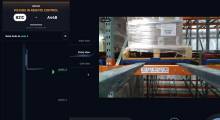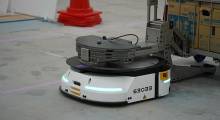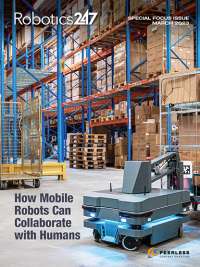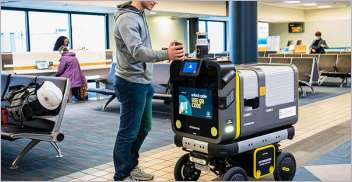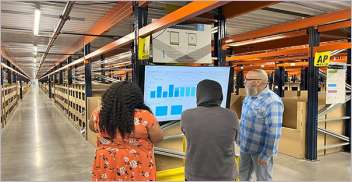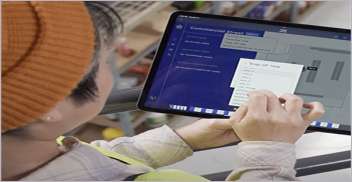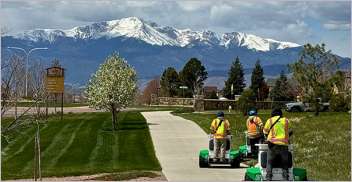Fleets of robots are growing in capacity and functionality, and so is the need to manage them, whether through software or robotics-as-a-service, or RaaS, models.
Organizations are searching for best practices and tools to operate, manage, and maintain their robot fleets. These considerations apply to almost any system promising greater efficiency, from automated guided vehicles (AGVs) and autonomous mobile robots (AMRs) to semi-autonomous and self-driving lift trucks.
The industrial robotics market was worth abut $41.7 billion just two years ago, according to Zion Market Research. It could grow to about $81.4 billion—about $250 per person in the U.S.—by 2028 and grow almost 12% year over the next few years, predicted the research firm.
Similarly, SPER Market Research forecast that the global market for robot fleet management software will experience a compound annual growth rate (CAGR) of 34.02% between 2023 and 2032.
Fleet management tools tackle complexity
As robot fleets grow, developers are offering platforms built on top of operating systems, and they can be complex. Such tools can assist operations managers by providing useful information to drive everyday decisions about robot positioning, history, programming, and task assignments.
In many large facilities such as warehouses and distribution centers, AMRs are dispersed assets. Robot deployments can certainly help overall efficiency, but analyzing and sharing data about their status and operations may involve custom algorithms.
Let’s look at some of these tools and explore just how they might be used.
NVIDIA Isaac ROS takes robots to the edge
In October 2022, NVIDIA Corp. released Isaac ROS Developer Preview (DP) 2, which uses the open-source Robot Operating System (ROS 2) to enhance robot capabilities with advanced cloud and edge software.
The company said its updated software included innovations and features for robustness, including an array of task management tools for AMR fleets. ROS 2 developers can use it to develop additional capabilities for their unique applications, it said.
Specifically, NVIDIA's Isaac ROS includes individual packages called GEMs (Generalized Machine Learning Systems) and comprehensive pipelines known as NITROS (NVIDIA Isaac Toolkit for Robot Operating Systems). They are designed to unlock hardware-accelerated performance.
In April, NVIDIA announced Isaac ROS DP 3. It includes a new automatic map localizer, updated NvBlox with human detection, a benchmarking tool for ROS 2 graphs, and open-source NITROS packages. It supports the NVIDIA Jetson Orin Nano and Jetson Orin NX platforms, as well as the NVIDIA Jetson Orin Nano Developer Kit.
MiR optimizes fleets in the cloud
In another example, Mobile Industrial Robots ApS (MiR) in March introduced MiR Insights, a new cloud-based platform for optimizing the performance of mobile robot fleets. The software is intended to allow fleet owners to track and analyze the operations of their robots, providing actionable insights to drive performance improvements and increased uptime.
MiR Insights reads data from the MiR Fleet software, but it does not interfere with fleet operations, individual robot control, or fleet settings, noted the Danish AMR provider. Data is stored securely in the cloud, it added.
Fleet operators can use MiR Insights to make informed decisions. They can assess overall mission effectiveness, identify recurring challenges in production areas, and evaluate the effects of recent changes on robot throughput.
In addition, the software offers streamlined access to technical data, enabling faster and more efficient troubleshooting, said Mobile Industrial Robots. Some of the tool's key features include data dashboards and heat maps.
- Data dashboards: These convey key performance indicators (KPIs) such distance driven, completed missions, and robot utilization rate through intuitive dashboards.
- Heat maps: This feature enables users to visualize robot activity over time and different physical locations. They can identify areas with poor Wi-Fi coverage and potential traffic bottlenecks.
MiR Fleet is hosted on Microsoft Azure, ensuring robust data storage and security, claimed Mobile Industrial Robots. MiR Insights offers flexible data-visualization options and an API for the integration of raw data into external systems, it said.
Furthermore, MiR Insights is designed for continuous evolution based on customer experience and is focused on continually improving AMR fleet operations, according to the company.
FORVIA uses robots, software to optimize operations
In one real-world example of how fleet management software is being used, Tier 1 automotive supplier FORVIA installed 14 AMRs from Mobile Industrial Robots at its Fauercia Clean Mobility plant in Písek, Czech Republic. The company said it realized a return on invesment (ROI) from the fleet in less than two years.
Before FORVIA initiated the project, shop-floor logistics relied mostly on manual processes, forklifts, and stacking equipment. In fact, the risk of human injuries was quite high, so the company decided to automate its heaviest and most dangerous processes to increase safety and productivity.
FORVIA used MiR Fleet to organize its missions, optimizing the logistics flow to and among production lines, all while communicating with doors, gates, and a strapping machine. The operation is fully automatic, and the company said it hopes to integrate MiR Fleet with its enterprise resource planning (ERP) system.
Seven of FORVIA’s heavy-duty robots, mainly MiR600s, bring empty pallets to the assembly lines and pick up full pallets of finished goods to the logistics area. MiR250 AMRs operate in a second area moving components from the warehouse to assembly lines. The robots in the plant work 24 hours a day, seven days a week, covering all three operation shifts.
As robotic fleets become larger and more complex, operators are seeking more effective tools, such as cloud-based software, to manage all facets of fleet management and operations.
About the Author
Follow Robotics 24/7 on Linkedin
Article topics
Email Sign Up







